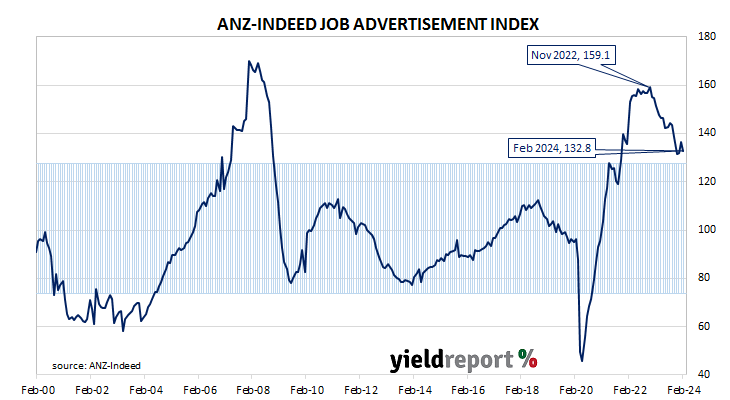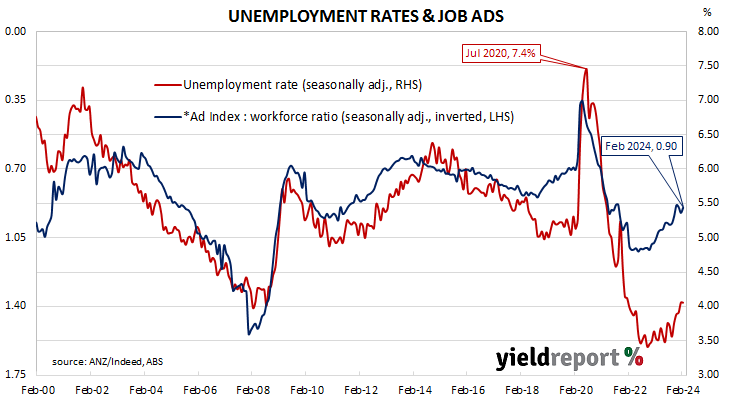Summary: Job ads down 2.8% in February; 12.3% lower than February 2023; ANZ: index resumes downward trend; ACGB yields fall moderately; rate-cut expectations firm; ANZ: scope for jobless rate to rise further; ad index-to-workforce ratio declines.
From mid-2017 onwards, year-on-year growth rates in the total number of Australian job advertisements consistently exceeded 10%. That was until mid-2018 when the annual growth rate fell back markedly. 2019 was notable for its reduced employment advertising and this trend continued into the first quarter of 2020. Advertising then plunged in April and May of 2020 as pandemic restrictions took effect but recovered quite quickly, reaching historically-high levels in 2022.
According to the latest reading of the ANZ-Indeed Job Ads Index, total job advertisements in February fell by 2.8% on a seasonally adjusted basis. The index fell from 136.6 in January after revisions to 132.8 and it follows gains of 3.4% in January and 0.6% in December. On a 12-month basis, total job advertisements were 12.3% lower than in February 2023, down from January’s revised figure of -11.6%.
“ANZ-Indeed Job Ads resumed its downward trend in February, falling 2.8%,” said ANZ economist Madeline Dunk. “This follows a softer than expected labour force survey in January, where hours worked fell 2.5%, employment grew by just 500 and the unemployment rate rose to 4.1%.”
The update was released on the same day as the Melbourne Institute’s latest Inflation Gauge reading and January dwelling approvals data and Commonwealth Government bond yields fell moderately on the day, lagging noticeable falls of US Treasury yields on Friday night. By the close of business, the 3-year ACGB yield had lost 3bps to 3.68%, the 10-year yield had shed 4bps to 4.12% while the 20-year yield finished 2bps lower at 4.43%.
In the cash futures market, expectations regarding rate cuts later this year firmed. At the end of the day, contracts implied the cash rate would remain close to the current rate for the next few months and average 4.315% through March, 4.305% in April and 4.27% in May. However, August contracts implied 4.15%, November contracts implied 3.98% and February 2025 contracts 3.85%, 48bps less than the current rate.
“The downward movement in Job Ads suggests there is scope for the unemployment rate to rise further, as do recent changes in labour market flows,” Dunk added. “That said, we think most of the near-term adjustment in the labour market will be via a fall in hours worked rather than employment.”
The inverse relationship between job advertisements and the unemployment rate has been quite strong (see below chart), although ANZ themselves called the relationship between the two series into question in early 2019. A higher job advertisement index as a proportion of the labour force is suggestive of lower unemployment rates in the near future while a lower ratio suggests higher unemployment rates will follow. February’s ad index-to-workforce ratio declined from 0.92 after revisions to 0.90.
In 2008/2009, advertisements plummeted and Australia’s unemployment rate jumped from 4% to nearly 6% over a period of 15 months. When a more dramatic fall in advertisements took place in April 2020, the unemployment rate responded much more quickly.



